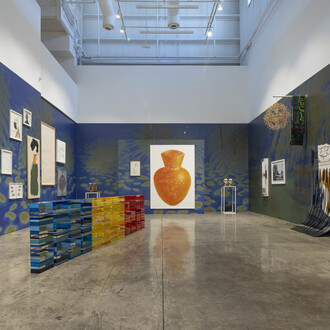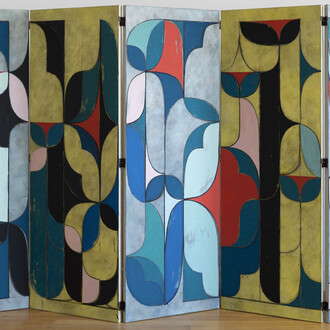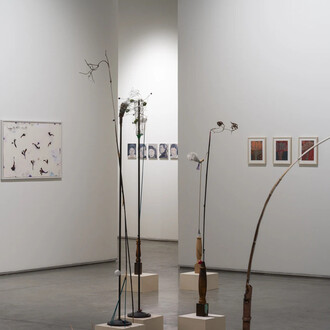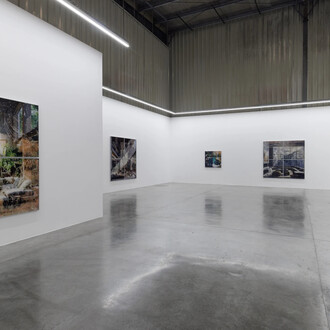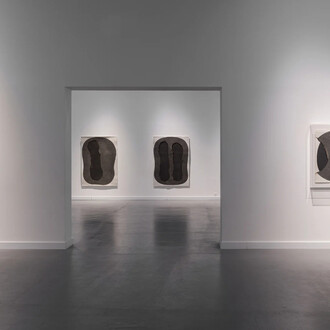Ayyam Gallery Dubai (12, Alserkal Avenue) is pleased to announce A Temple for Extended Days, a solo exhibition that marks the addition of Khaled Hafez to the gallery’s roster of artists while inaugurating its new outpost.
Characterised by dichotomous juxtapositions of epochs, genres, and cultures, whether in its earlier, eight-year-long abstract phase or in the subsequent transition to the hieroglyphically figurative, Hafez’s practice demonstrates an inclination towards the collision of worlds.
In a multimedia corpus that clearly borrows from Egyptian iconography, slender deities wander with aplomb to cross paths with emblematic modern-day heroes, military warfare, and mass media symbolism, to prove that the past is constantly recycled in order to reassure the present; and perhaps even to lift the curtain on an indiscernible porch between artificiality and reality, defined by French philosopher Jean Baudrillard as ‘the third order of simulacra’ in his 1981 treatise Simulacra and Simulation. According to Baudrillard, post-modern culture has grown so dependent on archetypes that it no longer is capable of distinguishing the natural realm from its fabricated counterpart.
Through anthropomorphic representations that confer to his work a futuristic semblance, Hafez mirrors Baudrillard’s views, with a penchant for aesthetic dissidence—he breaks free from the traditional rules of composition and colour subjugation, albeit managing to conjure movement in his flat graphic surfaces, reminiscent of ancient tomb walls.
In A Temple for Extended Days, Hafez’s syncretistic tendencies bubble up to the surface; the exhibition is entered as a place of worship, in which his Tomb Sonata in Three Military Movements (2010), a large-scale work originally created on canvas, is projected onto three walls that envelop the viewer to the solemn sounds of Mohammad Saleh’s melancholic composition. Following an initial lapse of stillness, Hafez’s heroes and foes are set in motion on a mosaic-like pastel background disrupted by controlled paint drips—a meagre, scantily clad female with a throne-shaped Pharaonic headdress boldly stares from one corner while a fusion of Anubis with a muscly bodybuilder occupies the opposite side of the projection space. With their presence, Hafez points out today’s tendencies of hyper buffering physical appearance at the expense of intellectual autonomy.
The installation’s central part is populated by more dual figures, adjacent to snipers, bombers, and choppers whose dark shapes establish a menacing tone. The pantheonic feel of the room is reinforced by the presence of ten life-size busts, perfectly aligned on the floor into two rows. Each rising from a pile of sand, the robust superhero silhouettes extend into Anubisshaped heads, echoing the video installation. By rupturing the ground, Hafez alludes to an ideological earthquake—will it serve an apocalyptic revival of the dead, or rather, the rebirth of nature?
With the plethora of playful ambiguities and ancient allegories contained in Hafez’s works, the emotional register of the exhibition widens from mischievous to sarcastic, dramatic, nostalgic, and ultimately, prophetic. Amplified in its sacredness by the presumed sanctity of the gallery space, the installation acts as a snapshot of humanity’s march towards a binomial outcome— self-destruction through violence and egomania, or rather, salvation with the retracking of society. Nodding to the idea of premonition, what Hafez concedes is an overall optimistic epilogue.










